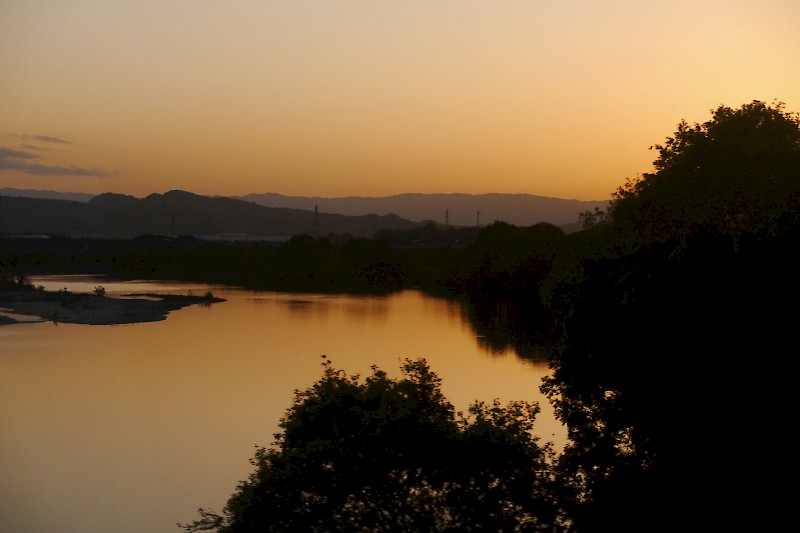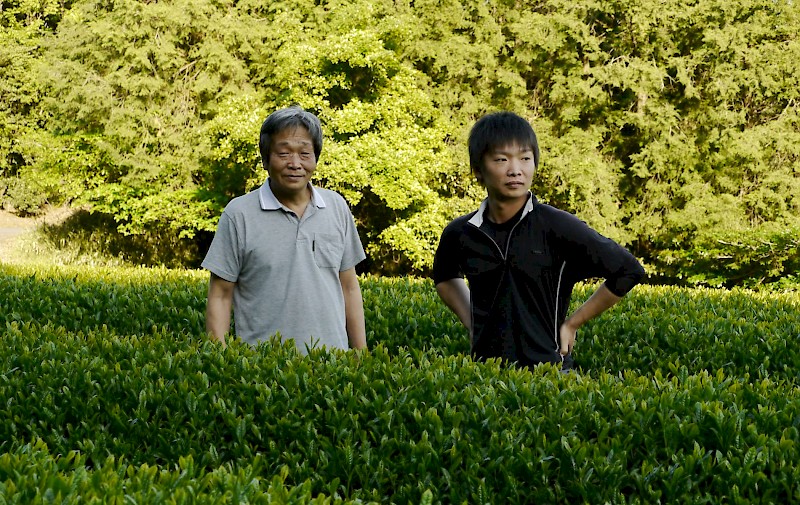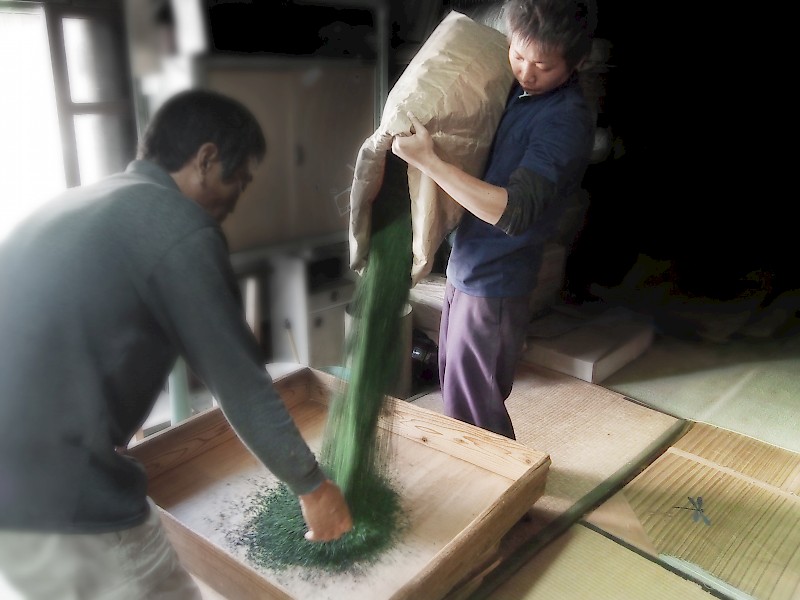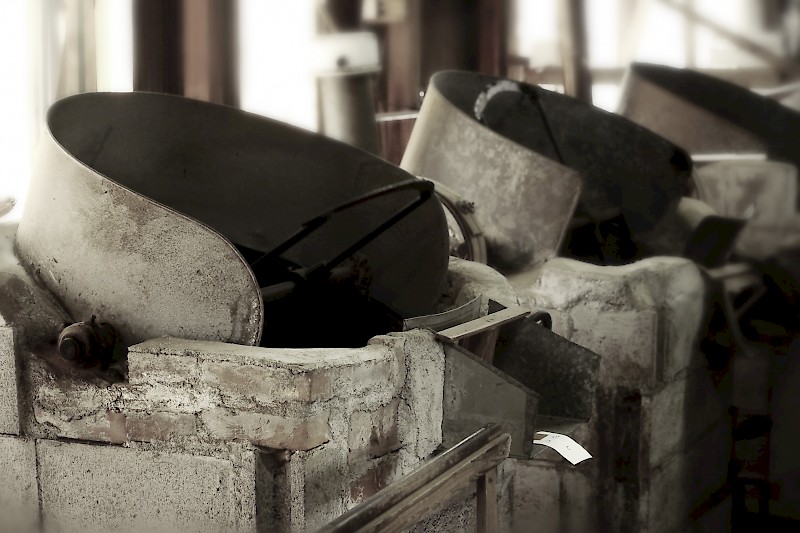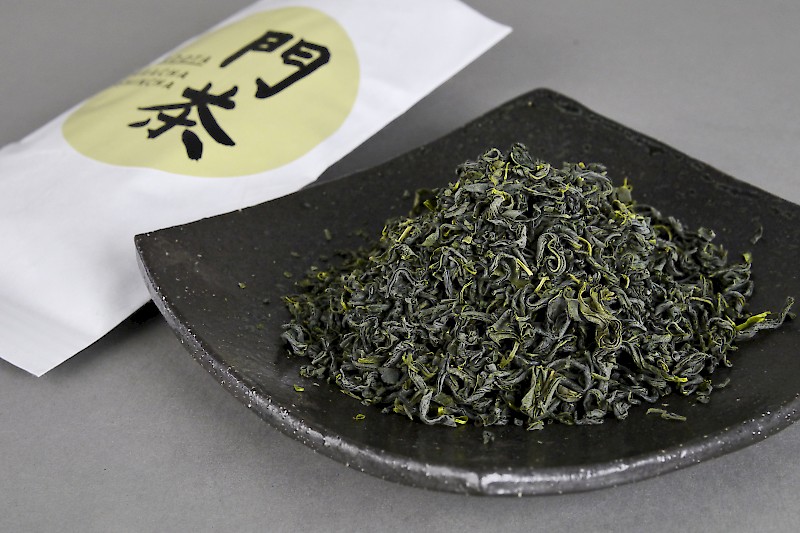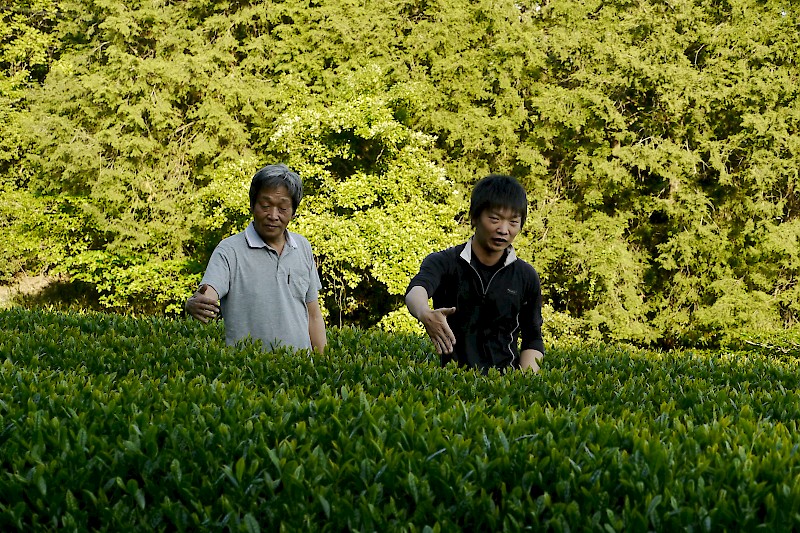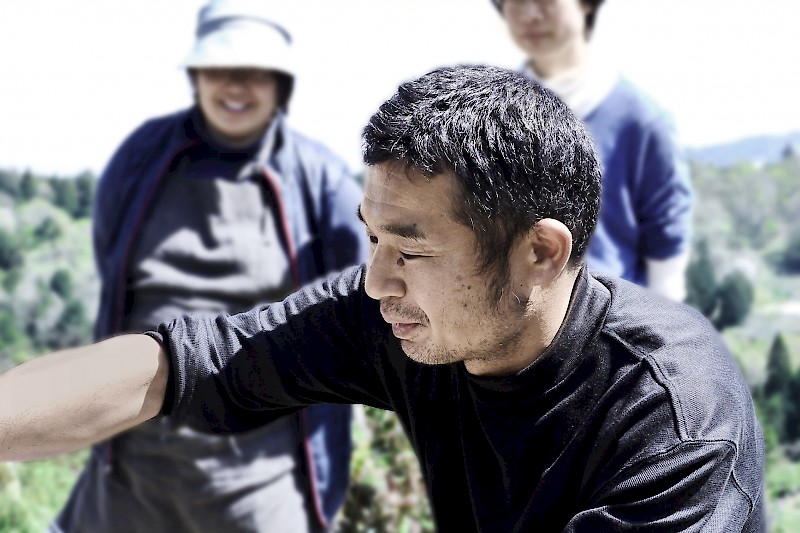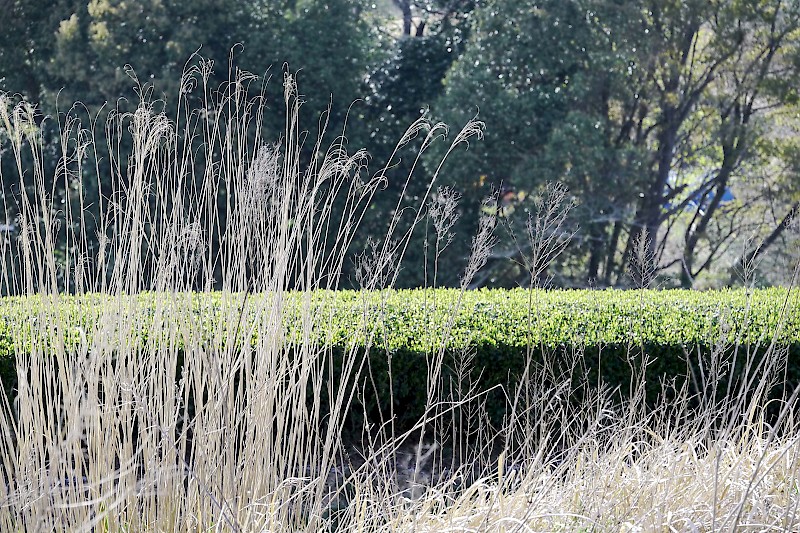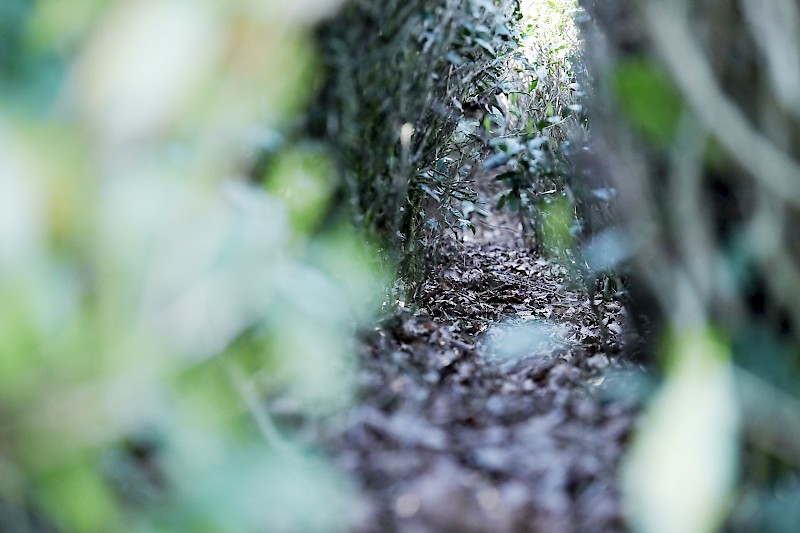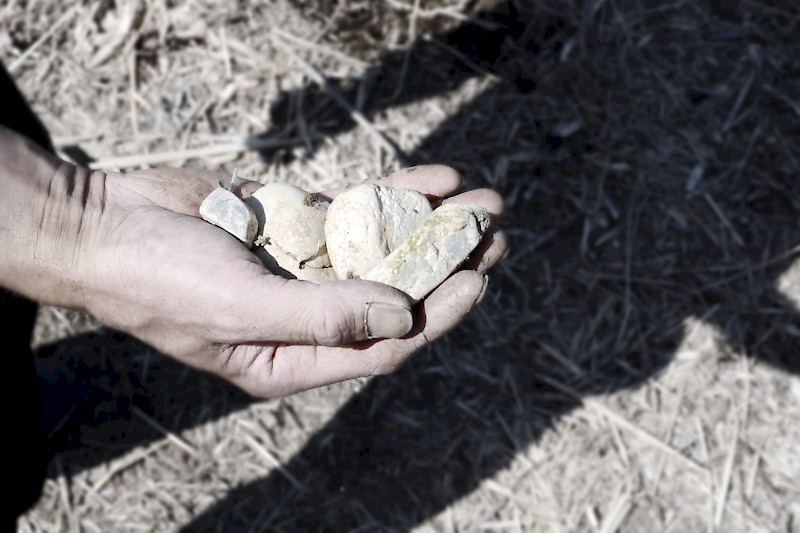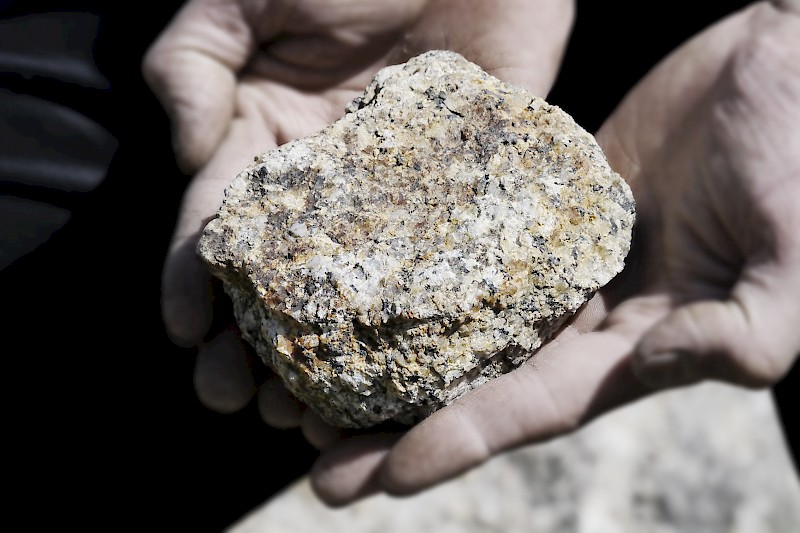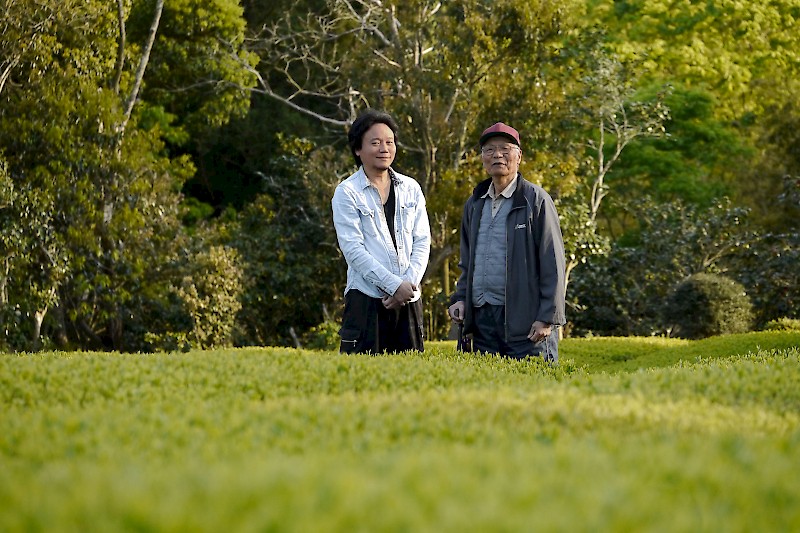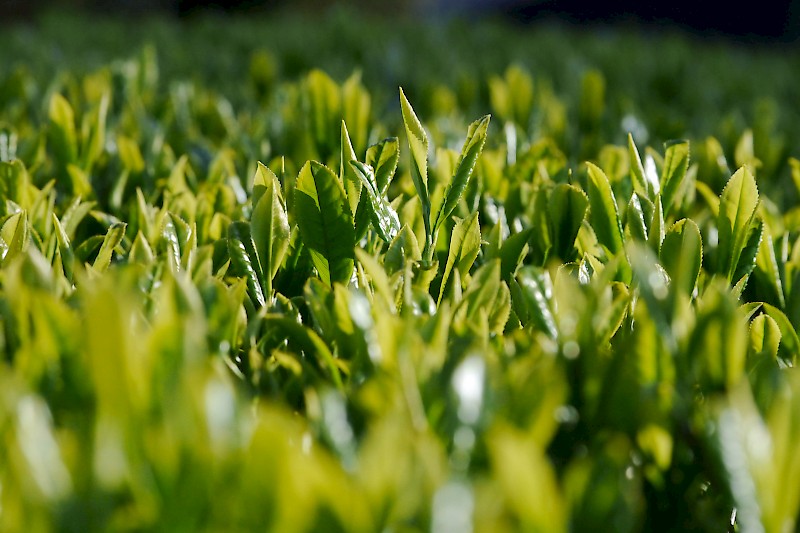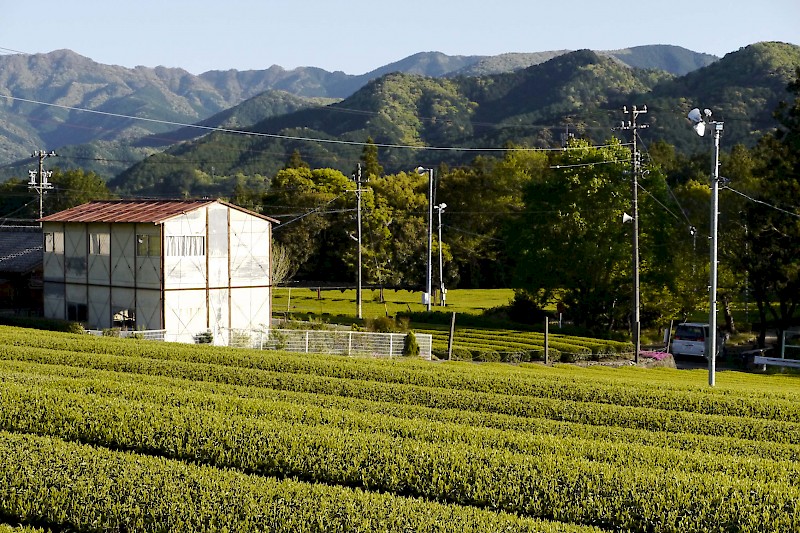MARIMO tea - Manufacture, Import & Wholesale
BLOG – April 2018 – Tea garden visits in Japan during the Shincha season 2018
26th April 2018 – Producing tea with historical cast iron apparatuses and new charm – A day with Kadota & Kadota
For days, we have been full of anticipation, and we especially changed the day of visiting father and son Kadota one day, so that we can be there exactly on the first day of harvest and production in 2018. When we arrive in the small Kadota family garden, not far away from the Morimoto tea garden, a paradisiac, flowery-sweet scent welcomes us.
Today, it is green leaves of the tea bush variety Yabukita, which are first heated, rolled, and then dried in various steps in a well-tempered heat progression. With only 2,6 hectare the Kadota tea garden is one of the smallest ones. Junji Kadota and his son Yusuke Kadota took over the direction of this traditional firm some years ago. Until then, Junji’s father was in charge. Yet, with age there came the time when he was not longer able to fulfill his duties in the tea garden and tea production. Then, Junji and Yusuke both quit their jobs simultaneuosly, to concentrate completely on the production of the and the continuation of the family garden. Of course, they had always been helping in harvest season, so both had many years of experience in the tea production.
Photo: Junji and Yusuke Kadota
Also from the point of view of father and son Kadota, the way of tea production which is performed here, is a precious treasure – one which is now unique in Japan. The cast iron apparatuses used here are already between 50 and 100 years old. All processes are reduced to their essence. There are no conveyors, which transport the tea from one drying drum to the next. All is done by hand. With all their senses, the Kadotas examine structure, smell, humidity, and elasticity of the leaves, and decide how long the single steps of drying are to be done. When they decide that the tea leaves have reached the desired stadium, they take out the leaves from the respective cast iron Kama and fill them to the next apparatus. Son and father are absolutely concentrated during work; they are calm and at peace. One understands: they both know exactly what they are doing. They are one with the tea that they are producing.
Photo: Kadota Kamairicha: 100-years-old Hon-Gama
Highlight of the processing, of course, are the 100-years-old Hon-Gama (“Real Kama”), three of which once belonged to Shigeru Morimoto’s father Ryotaro Morimoto. When he quit making Kamairi and shifted to making Sencha, he gave the old Hon-Gama to the Kadota family, which is still using them nowadays. Ryotaro Morimoto and also Junji’s father still fired the old Hon-Gama with wood. However, smoke and gathering the right firewood continued being problematic, so today Junji and Yusuke Kadota use gas flames to heat all their Hon-Gama. Indeed, this is the only thing they changed in the old manufactory.
When asked how long the tea stays in the Hon-Gama, Junji answers that he knows from the smell when the tea is ready. It changes from a rather flowery to a sweet fragrance. When they fill in the tea, we can briefly take a smell at the still humid leaves. Two hours later, we come back to the same Hon-Gama and can clearly notice the change as well. The whole room is filled with a scent – not the flowery scent of the beginning of today’s production but a fine sweet one. We wish we could stay in this room for ever.
In a small side room, Yusuke is preparing the freshly produced Aracha Shincha from today for us. The same fine sweet fragrance is arising from the Kyusu. In dry state, the leaves are still silvery-blueish; in the Kyusu they unfold soon and shine in a bright, fresh green. We also clearly perceive the flowery-fresh nuance from the beginning of the production. Together, this results in a combination of a refreshing taste, which stays in the mouth for a long while, with a long, flowery aftertaste lingering. We are so impressed that we take a small amount as this year’s surprise Shincha to Europe:
Kadota Aracha Shincha.
Photo: Kadota Aracha Shincha 2018
Kadota tea bushes and locations
The Yabukita which was harvested today for the Kadota Aracha Shincha, is the earliest sprouting variety in the Kadotas’ traditional tea garden. The other varieties Kanaya Midori, Yamaminami and Zairai begin to sprout later. They decided to grow these varieties in their tea garden, on one hand because – except Yabukita – they are all traditional Kamairicha varieties. On the other hand, Kadota & Kadota have to cultivate late sprouting varieties in their tea garden, because they could not set up fans as a protection from late night frosts in their parcels. This way, the tea bushes start growing their sprouts in spring, after most of the frost has passed already. Today’s Yabukita comes from the location Odateyama, around 250m above sea level.
Photo: Junji and Yusuke Kadota in the Odateyama tea parcel: Yabukita for the Kadota Aracha Shincha
Although it is comparatively cold up here, the tea garden parcel is surrounded by trees and thus well-protected. The Kadota family has been cultivating this parcel for several generations already.
Really modern Kamairicha factories do not exist, but in the few still-existing Kamairicha firms – apart from the first heating which is done with dry-heating instruments called “Kama” – different machines are in use, which were originally developed for the Sencha production. Instead of Hon-Gama cast iron apparatuses – as they are still used in the Kadotas’ place – much more efficient Suikan machines are being used. One Suikan machine replaces about three open Hon-Gama. However, the taste of a tea produced with Suikan machines is not the same. Junji explains us that the oxygen exchange during the last drying step to Aracha (around 5% remaining humidity) brings out the scent of the tea very well. When using a closed Suikan-drum, this kind of oxygen exchange does not take place. That means, using the historical apparatuses is essential for bringing out the unique aroma of the Kadota teas.
21th April 2018 – Observing nature – Visiting the Suikyo tea garden
Today’s journey leads us into a very remote region in Nara prefecture. Most travellers in Japan know the city of the same name, with its beautiful temples, the grand Buddha statue, and deer running free in the park. However, we are going to a completely different part of the prefecture – a mountainous region, the origin of the tea known as “Yamatocha”.
We are meeting with Fumiaki, Luna and Yoko today. In the beginning, Suikyo was a family garden, which Fumiaki took over from his parents. His father had already converted the garden to organic farming when Fumiaki was a child, around 35 years ago. The new generation added further ideas, which – together with organic farming as a fundament – contribute to the special form of farming in the Suikyo tea garden.
Photo: Fumiaki, Luna and Yoko of the Suikyo tea garden
While the father had already started certified organic farming, he still used organic fertiliser as usual, among them fish meal. After his son Fumiaki had taken over the garden and dedicated himself more and more to the bushes and their detailed flavour nuances, he found out that his tea bushes, which were fertilised with the organic material they used up till then, took on parts of the flavour and smells of the fertilisers used. He found out that because of this tea fertilised with fish meal, which is quite common in Japan, therefore also shows fishy nuances in fragrance and taste.
For Fumiaki the natural taste of the tea leaves is the most important. So from then, step by step, he stopped using any kind of fertiliser of animal origin. Fumiaki thought carefully how he can adequately take care about the bushes. In 2005, he first started changing the fertilisers for the tea garden parcels which he used for producing black tea. Since then, he is using leaves from the surrounding forests and grass, which he is growing himself on special fields.
Photo: Suikyo tea garden in Nara
The amount of tree leaves and grass is not choosen randomly. Fumiaki calculates how much bio mass he takes from the eco system of the tea garden by harvesting the leaves of the tea bushes. And he gives back exactly that much. Fumiaki decided to use tree leaves and grass because they are most similar to tea leaves in their composition. Regarding the nitrogen in grass and leaves – probably the most important macronutrient in plant growing – he fertilises only about one seventh of the amount other producers do. However, grass and tree leaves contain much more other minerals and micronutrients than other common fertilisers.
After shifting to this way of fertilising, he noticed that some tea bush varieties developed an intense citrus scent, which Fumiaki could not perceive before. Of course in this extensive land cultivation harvest yields are far smaller than in other tea gardens. It is around 30-50% of the average production quantity. We also see this in the tea bushes: they are very strong and healthy but form much less new sprouts than we know from other tea gardens. Until 2011, the complete Suikyo tea garden was converted to this form of natural cultivation.
In our talk, Luna and Fumiaki emphasize that observing the tea bushes is very important for them. Contrary to the rather formalistic approach in conventional tea production, where certain intervals are set in advance, in which specific pesticides or fertilisers are applied, the Suikyo team is observing the plants, their growth, the taste of the leaves, the development of the roots, and the way and pace in which their grass and tree leaves fertilisers are turned into humus. In the beginning it still took very long but now it is very fast and almost changing right in front of your eyes. For good composting, the tea bush rows are cut with only very little space between them. This way, almost no sunlight reaches the ground and it stays humid even after several days without rain.
Photo: Grass and tree leaves fertilisation in the Suikyo tea garden
During the winter months, Fumiaki, Luna, Yoko, and the other members of the Suikyo team dedicate themselves to studies. They take classes and workshops about scientific soil analysis, but also about the topic of biodynamic cultivation methods. And they combine this theoretical knowledge with the observations in their tea garden.
The Suikyo tea garden is divided in parcels which they call tea gardens (Ochabatake) and parcels they call tea mountains (Ochayama). It is interesting that between the generations, different words are used: While the grandfather always talked about going to the tea mountain (Ochayama), with Fumiakis father it became normal to talk about going to the tea garden (Ochabatake). Tea gardens are areas that were flattened or straightened by humans. From the middle till the end of the 20th century, with the successive mechanisation of agriculture, many tea gardens were set up in a flat way, to make fertilisation and harvest with small machines possible. This process of straightening changed the soil structure. At the moment, there are still seedling-grown tea plants on the flat parcels in the Suikyo Garden. Their roots are rather shallow, which fits quite well to the man-made soil structure. The surface of the tea garden was enrichened with soil that is rich in humus, so that the shallow-rooted seedlings can reach the nutrients well. Seedlings, with their shallow roots that are reaching out horizontally, cannot reach deeper layers of soil, so the flat tea gardens of Suikyo are fertilised with grass and leaves and additionally rapeseed pomace, to ensure the bushes are nourished sufficiently.
Photo: Stones in the ground of a Suikyo tea mountain - a former riverbed
In the tea mountains of Suikyo the situation is completely different. Here the ground was not straightened and so the original soil structure was largely preserved. In “tea mountain” locations, at Suikyo, seed-grown plants are growing – yet this does not mean, that it is mainly regular Zairai, where the origin of the variety is completely unknown. No, at many tea mountain locations at Suikyo there are tea bushes which were grown from the seeds of specific varieties, that means Mishou tea plants, for example Mishou Sae Midori. They grow thick, downward growing taproots which enable the plants to reach very deep soil layers and access the nutrients there. Partly, there are some Zairai tea mountains but also quite many Mishou tea mountains. Some are over 50 years old, and one Zairai tea mountain is more than 100 years old. By the way, we have already talked about Mishou a little bit in our 2017 Japan tea travel blog.
To be precise, Mishou are plants from the seeds of, genetically seen, one single mother plant. They were pollinated with the pollen of various father plants, so characteristics of both parent plants are combined. So, Mishou plants are closely related but not completely identical. A bush of Mishou Sae Midori can be very similar to the variety Sae Midori, or less similar. By selecting the young plants, it is possible to influence a Mishou tea garden to develop stronger into the direction of a desired variety than it would happen by a random process.
Photo: Volcanic soil in the Suikyo tea garden
Today we also visit two tea mountains at Suikyo, which are currently built up with Mishou. Last year, the Suikyo team started to newly built Mishou parcels. To have plants that are as similar as possible, 6 to 8 seeds are put into each seed hole. The plants that grow from there are examined phenotypically in a very early stage, and the plant which is most similar to the mother plant – and therefore most similar to the desired variety – is chosen. The other ones are taken from the ground. This way, a parcel is created which is seed-grown, and yet, the plants are largely similar in terms of the timing of the fresh sprouts in spring, the form of the leaves, and the taste. They are more stable than if you had simply planted seedling-grown Sae Midori, for example. The examination of the plants is not easy, so for this purpose Prof. Takeda is coming. He is a specialist for tea plants who breeded the Benifuuki in the 90ies. Just by looking with his naked eye, he can determine which plant is most similar to the target variety – in the tea mountain which we visited it is the Benihikari, a variety well-suited for black tea – that means, which plant carries lots of characteristics of the mother plant.
20th April 2018 – The vitalizing character of subtly heated tea – Visiting Iwao and Kimihiko Hayashi in Mie
It is our first tea garden visit this year! Finally we can admire the fresh green colour of the first sprouts of the year again. We are meeting Iwao and Kimihiko Hayashi. Here in Mie, the first sprouts are already visible but still very small. Kimihiko expects the first harvest of 2018 to start around 3rd or 4th May. To compare, in 2017 the first harvest day in Mie was 7th May.
Photo: Kimihiko and Iwao Hayashi in their tea garden
This year is really crazy: First, for a long time it was extraordinarily cold with frost in March and the beginning of April. Then, quite suddenly, the weather turned warm and partly changeably-rainy, so the tea bushes grew very fast. During our phone calls just two, three weeks ago, we were told this year’s harvest in Japan will take place as usual or a bit later, yet then the situation changed all of a sudden. Now, an early or even very early harvest year is expected. In the southern prefectures of Kagoshima, Kumamoto and Miyazaki, the first harvest of 2018 has already started.
Photo: Fresh tea leaves in the tea garden of Kimihiko and Iwao Hayashi
Although Iwao Hayashi – more than 80-years-old and great-grandfather by now – largely retired from work in the tea garden in mid-2017, the meeting with us is so important to him that he sits down with his youngest son Kimihiko and us. Our conversation turns to final processing and final heating. In an association of companies of the Japanese tea industry he heard that recently strong final heating is very popular for the Japanese market. With strong final heating, the leaves of various tea bush varieties largely lose their special and characteristic flavours. Moreover, with strong final heating, bitter and harsh nuances are largely lost. At the same time, teas produced in such a way develop nutty till roasty aromas. The taste of such stronger final-heated teas is relatively agreeable. Unpracticed tea drinkers can easily like this taste, which is called “kobashii”, as well. This tendency focusses especially on younger Japanese generations which cannot relate to very differentiated flavours – at least this is how the expectation goes. All these considerations are not about especially strongly final-heated tea sorts of the Houjicha category but about the degree of final heating of green tea sorts such as Sencha, Kabusecha or Tamaryokucha. Generally speaking, we find roast aromas, such as can be tasted in strongly final-heated Sencha sorts, also in many other food items, which are heated up to a slight or even strong browning. Our modern diet is full of roast aromas. Just think of the enormous amount of dishes which are roasted, baked or even grilled.
Photo: Tea garden of Kimihiko and Iwao Hayashi
We, as well as Iwao and Kimihiko, rather prefer a different flavour direction: A weaker final heating, that means using lower temperatures, preserves the characteristics of each tea bush variety, location and soil. So, both region and tea bush variety are brought out far better in a more lightly final-heated tea. There are far more subtleties to taste. The tea is vitalizing and at the same time refreshing and temperature-regulating, even when it is infused with warm water.

Our conversation slowly turns to the topic of organic farming. Iwao talks about his experiences in the 1970ies when he still used pesticides. When he sprayed pesticides, he protected himself with a protective suit, gloves and several breathing mask on top of each other. Yet, after work, he suffered headache so bad he thought his head would explode. When he told his neighbours about this, they just said that the effect was not so bad on them – it was bearable. For Iwao, these headaches were the beginning of the conversion process to organic farming. He could not imagine that it was really necessary to use such chemicals as they were used up till then, even if the cooperative always kept propagating them. Until nowadays, many farmers cannot imagine that it is possible to produce good teas without pesticides. Today Iwao tells us that his neighbours are more open to his ideas than around 40 years ago, when he – a pioneer of organic tea cultivation – was still looked down on.
Before we take some time to look at the tea garden, we talk about the creation of a new tea: Iwao and Kimihiko Hayashi plan to produce it with a rare tea bush variety from their garden. When we walk through the tea garden where this new tea is planned to come from, an enchanting fragrance awaits us. You can look forward to something new from Iwao and Kimihiko Hayashi this year!
